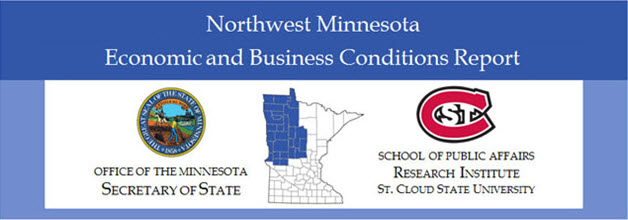Document Type
Research Study
Publication Date
7-2017
Abstract
The Northwest Minnesota planning area economy is expected to experience steady growth over the next several months according to the predictions of the St. Cloud State University Northwest Minnesota Index of Leading Economic Indicators (LEI). Two of the five index components increased as the LEI was essentially unchanged in the first quarter. An increase in the Rural Mainstreet Index (which signals an improving macroeconomic environment for rural America) and lower initial jobless claims contributed favorably to the first quarter outlook. Weaker residential building permits in Fargo/Moorhead and Grand Forks/East Grand Forks, and slower new filings for LLC and incorporation in the Northwest Minnesota planning area weighed on the first quarter index. Consumer sentiment declined slightly.
There were 1,195 new business filings with the Office of the Minnesota Secretary of State in Northwest Minnesota in the first quarter of 2017 — representing a 2.4 percent decrease from one year ago. Nearly 10 percent fewer new regional business incorporations were recorded compared to last year’s first quarter. In the first quarter, new LLC filings in Northwest Minnesota were up 1.9 percent from one year earlier—rising to 651. New assumed names totaled 383 in the first quarter—3.5 percent fewer filings than the same period in 2016. There were 40 new filings for Northwest Minnesota non-profits in the first quarter—fifteen fewer filings than one year ago.
Sixty-two percent of new business filers in the Northwest Minnesota planning area completed the voluntary Minnesota Business Snapshot (MBS) survey in this year’s first quarter. Results of this voluntary survey indicate that about 3 percent of new filers come from communities of color. Nearly 9 percent of new filers in Northwest Minnesota are veterans. More than 2 percent of new filers come from the disability community and less than 1 percent of new filings are made by the immigrant community. Thirty-nine percent of new business filings in Northwest Minnesota in this year’s first quarter were initiated by women. MBS results also show that most new business filers in Northwest Minnesota have between 0 and $10,000 in annual gross revenues (although 100 new filers have revenues in excess of $50,000). The most popular industries for new businesses in Northwest Minnesota are construction, retail trade, and other services. Employment levels at most new firms are between 0 and 5 workers, and 42 percent of those starting a new business consider this a part-time activity.
Employment of Northwest Minnesota residents declined by 0.2 percent over the year ending March 2017. The regional unemployment rate was 6.3 percent in March, which was lower than the 6.6 percent rate observed one year ago. The Northwest Minnesota labor force contracted by 0.6 percent over the past twelve months (there are now 1,705 fewer people in the regional labor force than there was one year ago). Initial claims for unemployment insurance in March 2017 were 11.1 percent lower than one year earlier and the region’s job vacancies remain elevated. Northwest Minnesota’s total bankruptcies were higher than one year ago.
Economic performance in the Fargo/Moorhead Metropolitan Statistical Area (MSA) was mostly favorable in the past quarter. This MSA tallied gains in overall employment (as well as job gains in the key mining/logging/construction and manufacturing sectors), lower initial jobless claims, a rise in the regional workforce, a lower relative cost of living, higher average weekly work hours and average hourly earnings, and a lower unemployment rate. The area did experience reduced valuation of residential building permits. Economic activity in the Grand Forks/East Grand Forks MSA was also largely favorable in the first quarter. Higher overall employment (including an increase in manufacturing and mining/ logging/construction employment), a rising labor force, a lower unemployment rate, higher average weekly work hours, and lower initial jobless claims all contributed favorably to regional economic performance. However, the area did see the value of residential building permits contract and average hourly earnings fall.
Recommended Citation
MacDonald, Richard A. and Banaian, King, "Northwest Minnesota Economic and Business Conditions Report - First Quarter 2017" (2017). Northwest Minnesota Economic and Business Conditions Report. 13.
https://repository.stcloudstate.edu/qebcr_nw_mn/13




